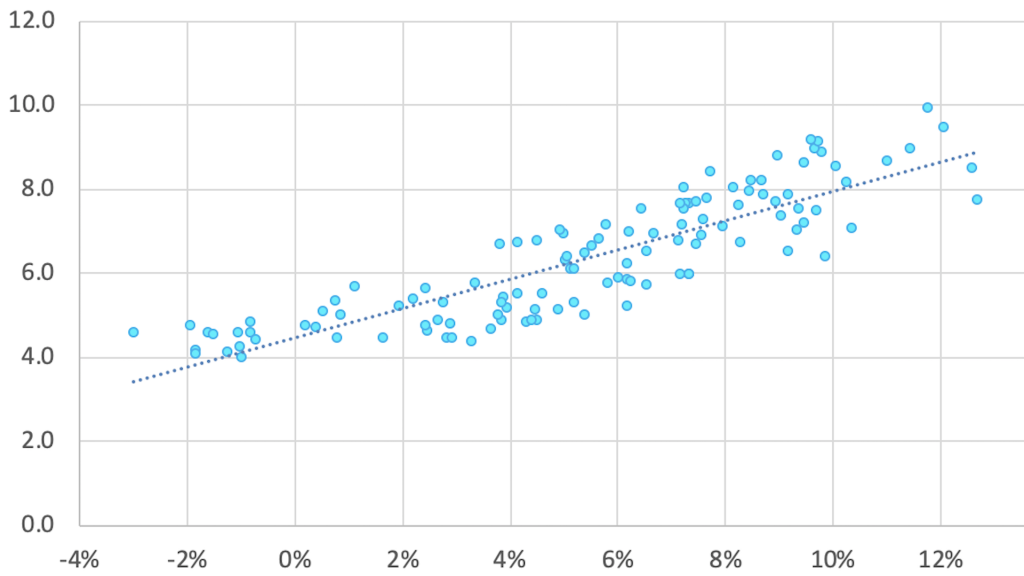The main lesson from the evidence on sustainable withdrawals is that a retirement spending strategy has to be adaptable, based on plans that allow adjustments over time to reflect changes in performance and priorities. The goal of an adaptable strategy is to take advantage of growth opportunities while protecting the long-term ability of the portfolio to generate income.
Mid-term performance and sustainable rates
As we showed in Part 2, periods with high sustainable rates have something in common: good 5-year and 10-year returns. In contrast, 30-year periods with low sustainable rates, say below 5%, all have relatively poor performance over the first 5-10 years. Monitoring performance over the first 5-10 years is therefore crucial to capturing opportunities to increase spending on goals. But how do we know if we should stick to the 4% or can increase spending?
To answer the question, let’s look at what low spending rate periods have in common. The figure below shows the 30-year portfolio paths for the periods where the maximum sustainable rate was less than 4.5%. There are 11 30-year periods like that (about 9% of all cases). Each line in the figure represents the value of a hypothetical portfolio over historical 30-year periods. The value of the portfolio is assumed to start at 100 every period.
Portfolio Value During Periods of Low Sustainable Rates (using 4% rule)
Source: DESMO Wealth Advisor, LLC calculations. Historical data from Rober Shiller from 1871 to 1925, and Ibbotson data from Dimensional Fund Advisors since 1926.
The general pattern is clear: as income is withdrawn over time, the value of the portfolio steadily declines. Even in the best of these 11 cases, the value never reaches 110% of initial value at any point in time, in inflation-adjusted terms.
Let’s now examine 30-year periods with sustainable rates greater than 4%, assuming, however, that we use the safe 4% rule. Because these periods can sustain higher rates, we expect portfolio value to increase. The question is how fast. Our analysis of the historical 30-year periods shows that if the portfolio value reaches 130 or higher at year 5 or year 10, we can expect a sustainable withdrawal of 6% of initial portfolio value or greater. The figure below shows the path of wealth for all the 30-year periods that reach 130 at year 5. All these paths end above 100 at the end of the 30 year period, consistent with the fact that they can all sustain higher rates than 4%.
Portfolio Value in Periods Where It Reaches $130 at Year 5 (using 4% rule)
Source: DESMO Wealth Advisor, LLC calculations. Historical data from Rober Shiller from 1871 to 1925, and Ibbotson data from Dimensional Fund Advisors since 1926.
Strategies
There is no guarantee that 130 percent of initial value will work in the future, but it is a sensible threshold. One way to use it is to start with a withdrawal level of 4% of initial portfolio value, then increase the withdrawal to 4.5% or 5% of initial value at year 5 if a threshold of 130 is crossed. After that, continue to monitor the portfolio and adjust spending every year to avoid substantial declines, at least until year 10. If the initial increase is small enough, say a 10% increase in spending (bringing the rate to 4.4% of initial value), you may never have to decrease your withdrawals. With this type of strategy, you start spending conservatively, then you ratchet up spending if things go well. It may work well if you have spending goals that can occur a bit later in retirement or goals that can be postponed.
Many other patterns are possible. For example, consider a couple retiring at age 66 with $1,700,000 saved. The 4% rule (with or without ratcheting) recommends that the couple withdraw $68,000. However, the couple would prefer to spend about $8,000 more a year in the first 5 years of retirement to travel instead of waiting until age 70 to potentially ratchet up their consumption. What can they do? They could set aside now $40K ($8K times 5 years) for that purpose, and start at 4% with the remaining assets, or $66,400 a year.
In total, the couple can withdraw $74,400 including the $8K for travel expenses for the first 5 years, a rate of 4.4%. At year 5, if their portfolios have appreciated by at least 25%-30% or more, they can continue to spend $74,400 (adjusted for inflation). If not, they go back to the planned spending of $66,400, without the vacation. They continue to monitor their portfolio for the opportunity to increase spending on vacations or other goals in later years.
Use Goals-Based Investing
There are many other possible combinations depending on your goals and priorities. One general approach is to start with essential needs, then subtract Social Security to figure out what you will need from your portfolio. Say you need $60K a year in essential expenses and $30K comes from Social Security, your personal savings will need to cover the remaining $30K. Multiply this amount by 25 (the 4% rule in reverse) to figure out how much capital you need to cover those expenses. This is your “essential portfolio.” In the example, you need $750,000 for essential needs.
If there is any capital left after taking care of essential needs at 4%, you devote the rest of your assets to high priority goals that have a shorter horizon, within the next five years or so. This contains items like the vacation example above. At some point in your goal prioritization exercise, you get to goals that are not affordable at a starting 4% rate, but may become affordable if returns in the essential portfolio are higher than expected. These are goals that should be part of the plan with lower priority. If the portfolio value at year 5 is in line with a higher sustainable rate, then you can consider devoting some of your portfolio to achieve these optional goals.
The lesson from our research indicates that you can navigate the uncertainty of future returns with greater confidence with an adaptable strategy based on your goals. The adaptability of the strategy allows you to take advantage of growth opportunities while safeguarding the spending you need for a comfortable retirement. A goals-based approach can help define your dynamic strategy. So start thinking about your goals and priorities today!
Until Next Time!
Massi De Santis is an Austin, TX fee-only financial planner and founder of DESMO Wealth Advisors, LLC. DESMO Wealth Advisors, LLC provides objective financial planning and investment management to help clients organize, grow, and protect their resources throughout their lives. As a fee-only, fiduciary, and independent financial advisor, Massi De Santis is never paid a commission of any kind, and has a legal obligation to provide unbiased and trustworthy financial advice.


